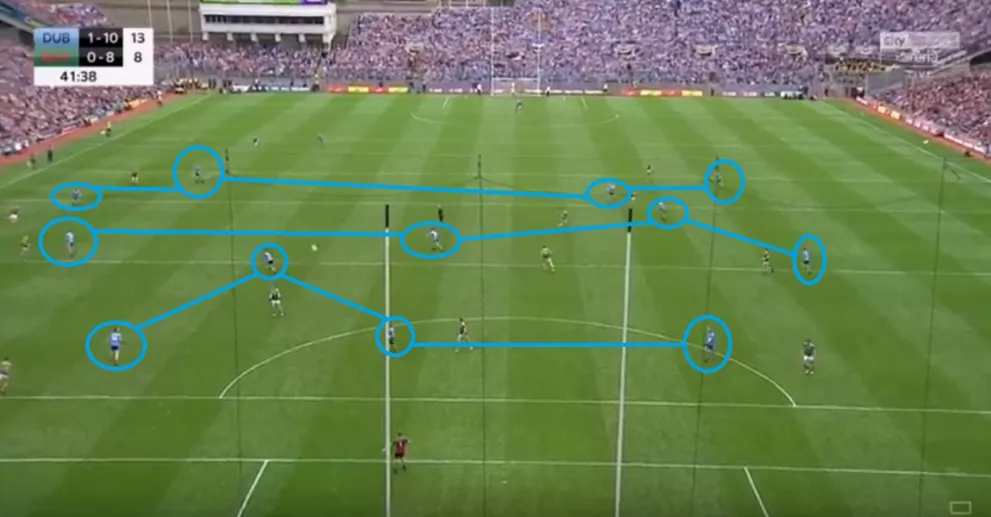
03 Oct Tactical Strategies: Maximising Our Strategies and Limiting Opponents (A-Z Series) – by Alan Mullen
In today’s fast-evolving landscape of Gaelic football, the role of tactics has never been more pivotal. Gone are the days when sheer athleticism or individual skill alone could guarantee success. Now, the ability to outthink and outmanoeuvre opponents on a tactical level is essential for any team aiming for victory. For coaches, developing and mastering tactical strategies is about striking a balance between maximising your team’s potential while simultaneously disrupting and limiting the opponent’s effectiveness.
This blog delves into two core principles: optimising your team’s strategies to enhance performance, and curbing the opposition’s ability to execute their game plan. Whether you’re looking to build a solid defence, orchestrate creative attacks, or outsmart your rivals in real-time, these strategies offer a roadmap to success.
Maximising Our Strategies
To achieve success, it’s crucial to first ensure that your team has a well-defined strategy that plays to their strengths. By focusing on key tactical areas, you can bring out the best in your players and create a cohesive unit that’s difficult to break down.
1.Building a Strong Defensive Structure
A robust defence is the foundation of any successful Gaelic football team. While some may favor an aggressive, man-to-man style of marking, others lean toward zonal systems where players guard areas rather than individuals. Each approach has its merits, but the key is to teach players to read the game and adjust accordingly.
The role of a sweeper, for example, can provide additional cover, especially against counter-attacks. By dropping deeper behind the main defensive line, a sweeper can clean up loose balls and prevent breakaway opportunities. Drilling your team to understand their defensive roles—whether they are covering space or marking players—can shut down opposition attacks before they become dangerous.
- Developing Offensive Plays
Effective attacking play is about more than just getting the ball up the field. Well-executed offensive tactics are built on movement, communication, and anticipation. Gaelic football rewards teams that transition from defence to attack with speed and precision. That means coaching players to find and exploit space, use overlaps, and stretch the opposition’s defensive lines.
A common strategy is to switch between quick transitions and controlled, patient buildup. Players need to know when to go direct and when to hold the ball, waiting for the right moment to attack. Forwards should be trained to make decoy runs, dragging defenders out of position to create space for teammates. The interplay between midfielders and forwards becomes crucial as they orchestrate these moves.
- Breaking the Defensive Block
As defence’s become more organised and teams set up in deep blocks, breaking them down requires creativity and sharp decision-making. Teams that rely solely on direct running can often be stifled by compact defensive structures. That’s why introducing variety into your attacking play is essential.
One effective way to break through is to use long-range shots to stretch defence’s, forcing them to step out and create space behind them. Another tactic is to overload one side of the pitch, dragging defenders out of position and then switching the play quickly to the opposite flank. Off-the-ball runs, intricate one-twos, and decoy movements are all tools in your attacking arsenal that can open up a well-drilled defence.
Limiting the Opponent’s Tactics
Just as crucial as maximising your team’s strategy is the ability to limit the effectiveness of your opponent. Neutralising their game plan and key players can swing the momentum of a match in your favor.
- Pressing and Forcing Turnovers
High pressing is one of the most effective ways to disrupt an opponent’s buildup play. By instructing your team to press as a unit, you can force the opposition into mistakes, panic clearances, or turnovers. However, pressing requires coordination; players must understand their triggers—such as when an opposition defender receives the ball under pressure or a weak pass is made. If executed correctly, pressing can suffocate the opposition’s rhythm and reduce their time on the ball.
- Nullifying Key Players
Every team has standout players, often the playmakers or sharp shooters who can turn a game with a moment of brilliance. Assigning a man-marker to these players can disrupt their influence on the game. The marker must be disciplined, staying tight but not overly aggressive, cutting off passing lanes, and shadowing the player’s movements.
Simultaneously, coaches should analyse the opposition for weak links—players who may struggle under pressure or lack speed or stamina. These areas can be exploited by focusing your team’s attacks in their direction, putting them on the back foot.
- Defensive Counter-Tactics
Defending isn’t just about protecting your goal; it’s also about denying the opposition opportunities to exploit your weaknesses. One effective strategy is doubling up on dangerous attackers, ensuring that your defenders can outnumber them in critical areas. Defensive units must also be able to adjust to the flow of the game, reading when to compress space in front of their goal or when to spread out and challenge attackers higher up the pitch.
Anticipating the opposition’s moves is another vital skill. A well-drilled defence that reads the game can intercept passes before they reach their intended targets or force attackers into low-percentage plays.
In-Game Adaptations
While preparation is key, being able to adapt during the game is just as critical for success. Gaelic football is fast-paced, and momentum can shift rapidly. Therefore, coaches must be prepared to make real-time decisions to counter the opposition’s moves or capitalise on weaknesses.
1.Reading the Game
Coaches must keep a keen eye on the ebb and flow of the match. Is the opposition changing its formation or attacking patterns? Has their playmaker dropped deeper to avoid being marked? Training your team to recognize these changes and react accordingly can turn a game in your favor. This flexibility requires practice, but the ability to change shape, adjust pressing intensity, or switch tactics mid-game is essential.
- Substitutions and Tactical Adjustments
Substitutions are a powerful tool in a coach’s arsenal. Beyond merely freshening up tired legs, a well-timed substitution can alter the dynamic of the game. For example, bringing on a fast, physical forward in the second half can stretch a tiring defence, while adding an extra midfielder might help regain control in the centre of the park.
Coaches must also be prepared to tweak their tactical setups—perhaps shifting from a defensive 4-4-2 to a more attacking 3-5-2 in search of a goal or dropping deeper when holding onto a narrow lead. These adjustments can be the difference between winning and losing in tight games.
Conclusion
Tactical mastery in Gaelic football is about both maximization and limitation. By optimizing your team’s strengths—whether that’s building a strong defence, crafting clever offensive plays, or executing effective pressing—you give yourself the best chance to succeed. Simultaneously, understanding how to disrupt the opposition’s flow, target key players, and adapt to changing circumstances on the field is equally critical.
For any Gaelic football coach, the game is as much a mental battle as a physical one. Success comes from preparation, understanding, and the ability to execute a strategic game plan while adapting on the fly. By developing these tactical insights, coaches can lead their teams to greater heights and more consistent success.



No Comments